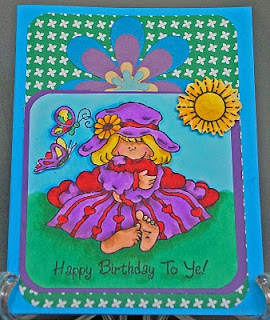Adding interest an dimension to your projects
Our lives are very colourful - green trees, blue sky, red, yellow and white houses. Take all these beautiful hues and add them to your scrapbook pages and greeting cards!
There are many ways to apply colour to your paper craft projects. One easy and enjoyable way is to colour in your stamped images. You can use crayons, paints, watercolour pencils, gel pens, markers or many other mediums.
 Currently, many crafters and artists make their images come to life using Copic Markers. These very high quality makers are available at local scrapbooking and rubber stamp stores as well as online. These are definitely not a child's marker and were originally created 25 years ago with the professional designer in mind. Over the last ten years, they have gained popularity with Menga artists and paper crafters. These non-toxic alcohol based markers are available in 334 colours and provide guaranteed colour consistency. They are refillable, have replaceable nibs that are guaranteed not to dry out for three years.
Currently, many crafters and artists make their images come to life using Copic Markers. These very high quality makers are available at local scrapbooking and rubber stamp stores as well as online. These are definitely not a child's marker and were originally created 25 years ago with the professional designer in mind. Over the last ten years, they have gained popularity with Menga artists and paper crafters. These non-toxic alcohol based markers are available in 334 colours and provide guaranteed colour consistency. They are refillable, have replaceable nibs that are guaranteed not to dry out for three years.They come in two types: the Sketch marker and the less expensive Chio makers. Most crafters prefer the Sketch markers. They have a round square shape that is easy to manipulate. You can use either the paintbrush like tip or the chisel tip depending on what you are colouring. When applying colour, no matter what you are using, the basic method is the same. Start with your lightest colour and then graduate to darker ones to add shading. You can use a white marker to add highlights on your finished work.
 The stamped image is your guide by following where the ink is heavier, showing you where you would use the darker colours. If you are using Copic markers, choose a gradient of colours that are about two colours apart, this will allow for easy shading. The markers also have a colourless blender marker, which is useful for picking up colour if you go outside the lines! It can also be used to lighten an area by pressing it lightly on your work, then just colour off the tip of the marker on a piece of scrap paper to clean it. Larger images are the best to start with as they give you more room to manipulate your colours. You do not have to colour in the whole image either, you can add touches of colour here and there as an accent.
The stamped image is your guide by following where the ink is heavier, showing you where you would use the darker colours. If you are using Copic markers, choose a gradient of colours that are about two colours apart, this will allow for easy shading. The markers also have a colourless blender marker, which is useful for picking up colour if you go outside the lines! It can also be used to lighten an area by pressing it lightly on your work, then just colour off the tip of the marker on a piece of scrap paper to clean it. Larger images are the best to start with as they give you more room to manipulate your colours. You do not have to colour in the whole image either, you can add touches of colour here and there as an accent. Once you get used to colouring and develop a style of your own there are many different techniques that you can use. Many stores and companies offer classes to help you get started and find new ways of doing things. You can also find many tutorials on line. The important thing is to be fearless in your exploration and always remember that every piece of paper has two sides! If you do something, you do not like just flip it over! For more information and on line content go to http://www.just2crafty.blogspot.com.
